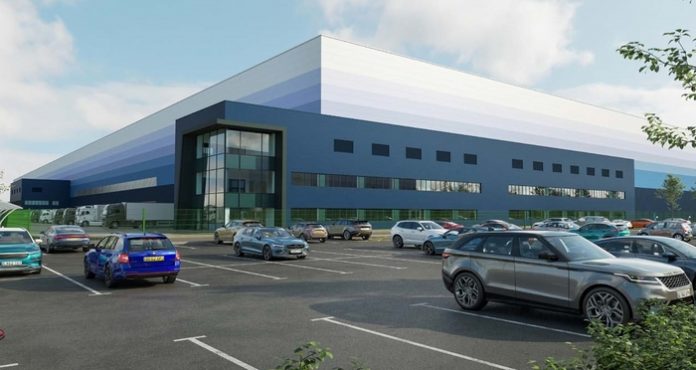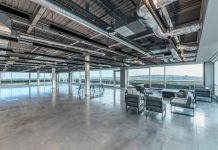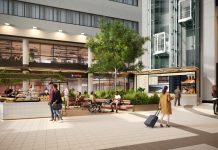An acute shortage of immediately available warehouse stock has influenced take-up across the Yorkshire industrial and logistics sector but speculative development is on the rise according to commercial property agents Knight Frank.
Following a record year for industrial and logistics transactions in South Yorkshire (including North East Derbyshire) and West Yorkshire (including The Humber) regions in 2021, which stood at 10.3m sq ft, the first quarter of 2022 recorded 1,022,200 sq ft of take-up for units over 50,000 sq ft.
Take-up in Q1 was restricted only by the lack of available premises and the continued levels of occupier demand has boosted developer appetite for new speculative development in the regions.
Rebecca Schofield, head of industrial at Knight Frank, looks at activity in South Yorkshire and North Derbyshire, through results from the firm’s LOGIC report for Quarter One 2022 (Q1).
“Notable deals in Q1 included the pre-let of 430,000 sq ft at Symmetry Park, Doncaster to B&Q and the pre-sale of 113,872 sq ft at Horizon 29, Chesterfield.
“The total take up for the twelve months to end-March 2022 was 5.1m sq ft, with distribution occupiers accounting for 71% of the take-up.
“As at the end of Q1 2022, approximately 754,800 sq ft was immediately available (units over 50,000 sq ft), of which 78% was under offer. With stock levels in South Yorkshire now at its lowest in years and a vacancy rate at an acute low of 1.3%.
“Strong occupier demand, coupled with the low levels of available stock has amplified the need for new development in the region. There is approx. 2.07 million sq ft currently under construction across 12 units in this region, expected to complete later this year or early 2023.
“Demand for these units is good and we expect this to positively impact take-up figures in the coming quarters.”
Speculative development underway includes schemes such as Mammoth 602, G Park and; iPort in Doncaster; and Ergo Park in Sheffield.
On investment, Nick Wales partner at Knight Frank added: “Investment into the logistics and industrial sector in South Yorkshire totalled £105.5 million in the first quarter of 2022, 29% higher than Q1 2021 volumes.
“In the twelve months to end March 2022, a total of £595.1 million was invested, the majority of which was from overseas, 58%. The four-quarter rolling total is also considerably ahead of the five-year average for the region, of £213 million.”
The average weighted yield for assets transacted across the South Yorkshire region over the past twelve months was 4.7%. This compares to 6.5% recorded in the comparable period last year and demonstrates the level of yield compression taking place across the industrial market at present.
There has been strong double-digit growth in rents across all size units in South Yorkshire over the past year. Prime rents in both Sheffield and Doncaster, for units over 50,000 sq ft, rose by 18% year-on-year, to stand at £7.00 per sq ft at the end of March 2022.
Rebecca added ‘’Average rental growth of 5.8% is forecast for Yorkshire & the Humber in 2022, with similar expectations for the Sheffield market, at 5.9%’’ (RealFor).
Commenting on the West Yorkshire market, Knight Frank partner Iain McPhail said: “The first quarter of 2022 recorded 398,300 sq ft of industrial and logistics occupier take-up in West Yorkshire & the Humber (units over 50,000 sq ft). While this is over half the level recorded in Q1 2021, the reduction is a reflection of the shortage of stock available in the market, rather than any dampening in occupational demand.
“The total for the twelve months ending March 2022 stood at 5.2 million sq ft, 18% higher than the comparable period last year and ahead of the five-year annual average. The retail sector dominates, accounting for 58% of activity over the past year.”
Total availability of units over 50,000 sq ft has more than halved over the past year, standing at 802,800 sq ft at the end of March, all of which is second hand, more dated stock. The region’s vacancy rate now stands at a record low of 1.2%, compared to 3.0% in Q1 2021.
Iain added: “The shortage of stock has led to a developer response, with a surge of new reserved matters planning applications being submitted during the past few months alone. Our latest figures suggest that there is circa 1.5 million sq ft which has now been granted full consent, with another 3.3 million sq ft proposed in the pipeline (speculative units over 50,000 sq ft).
“At the end of quarter one, there was only just under 360,000 sq ft of speculative space under construction in the region (units over 50,000 sq ft).”
New developments include Tungsten’s 230,000 sq ft Super B and 4th Industrial’s 65,000 sq ft unit, both at Interchange 26 in Cleckheaton and CBREIM’s OP65 (65,000 sq ft) in Leeds.
Looking at rental levels and outlook, Iain added: “The constrained level of supply is continuing to drive rental growth across all size ranges in West Yorkshire and The Humber.
“Prime rents in both Leeds and Wakefield, for units over 50,000 sq ft, have risen by 3.8% annually, and stood at £6.75 psf at end of March. However, new speculative developments are being marketed at quoting rents in the mid-£7.00s or higher, therefore we expect further significant rental growth this year. Average rental growth of 5.8% is forecast for Yorkshire & the Humber in 2022 with even higher expectations for Leeds, with 6.5% average rental growth forecasted (RealFor).”
Graham Foxton, partner in the capital markets team added that investment in the West Yorkshire industrial sector hit a quarterly high of £552.9 million in Q1 2022. This compares to £528.8 million invested in the whole of 2021.
“Activity was driven by one particularly large deal; Arrow Capital Partners acquisition of the 2 million sq ft distribution centre at Wakefield Hub, for £233 million in February, making up 42% of the three-month total.”
Q1 2022 volumes amplify the four-quarter rolling total for West Yorkshire, which stands just over £1 billion. This compares to the five-year average of £352 million. Overseas capital continues to be a significant source, accounting for 45% of the rolling total.
Summing up Rebecca commented: “There is continued demand from end occupiers including 3PLs, ecommerce and manufacturers and nature of demand from occupiers is being driven by location, labour, utilities and ESG. Interestingly a warehouse is no longer just a place to store product but now an office base. Many have head office functions where the well-being of employees is now at the forefront, just as it is for typical office occupiers.”






















